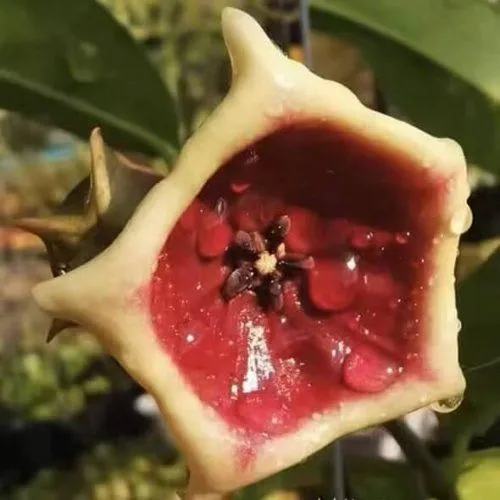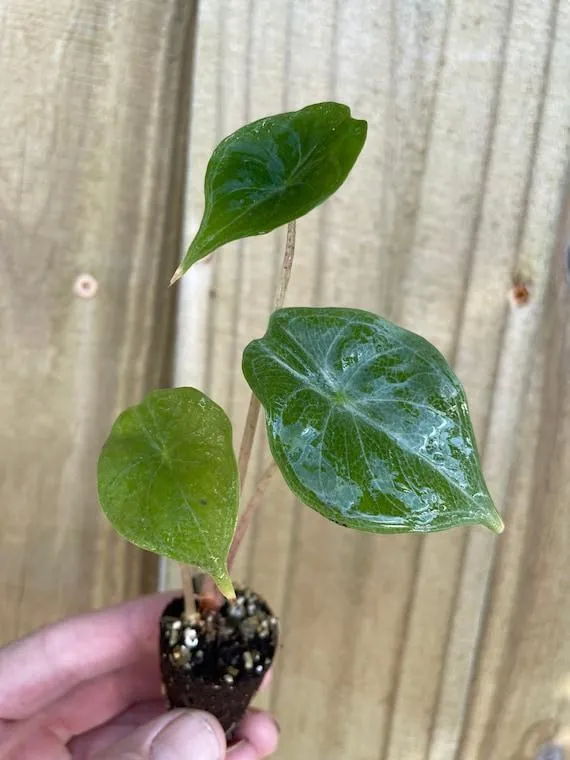Your Complete Guide to Growing and Caring for Anthurium Forgetii
The anthurium forgetii, commonly known as the flamingo flower, is a stunning tropical plant native to Ecuador. With its heart-shaped leaves and clusters of showy red flowers, it makes a gorgeous addition to any indoor or outdoor space. However, to thrive, this unique flower does require some special care. In this article, I’ll cover everything you need to know to successfully grow and care for an anthurium forgetii.
Getting to Know the Anthurium Forgetii
- Identification: The flamingo flower is easily identified by its large glossy leaves which can reach up to 12 inches long. The leaves have a waxy texture and colorful red veins. The flower stalks emerge from the centers of the leaves bearing clusters of bright red heart-shaped blooms.
- Growth habit: Anthurium forgetii grows as an evergreen perennial. New leaves continuously emerge from the center of the plant. It forms dense bushy clumps ideal for hanging baskets or as a tabletop plant.
- Blooming: Unlike many anthurium species, forgetii blooms almost continuously throughout the year if given optimal care. The vivid red flowers last for several weeks before new blooms replace them.
From my experience growing anthurium, the forgetii variety never fails to garner compliments for its uniquely colored blooms. The flowers really do resemble flushed flamingos! Its ability to bloom non-stop when happy makes it one of the showiest anthurium species.

Choosing a Spot
Anthuriums thrive in warm, humid conditions similar to their native rainforest habitat. When selecting a location for your forgetii, keep the following factors in mind:
- Bright, indirect light: Forgetii prefers eastern or western exposures where it receives morning or afternoon sun through a window. Too much direct sun can scorch the leaves.
- Humidity: The air should be at least 50% humidity. Use a pebble tray or room humidifier if indoor conditions are dry.
- Temperature: Daytime highs between 70-80°F and nighttime lows no cooler than 65°F are ideal. It may struggle at cooler temperatures.
- Protection: Anthurium is not frost hardy. Keep it away from drafty windows, vents and anywhere it could be exposed to chill.
In my experience, forgetii seems to do best when partially sheltered from the hottest afternoon sun. West or east-facing windows provide the light it craves without causing leaf scorching. The humidity-loving nature of anthurium makes bathrooms and kitchens great spots.

Potting and Soil
Forgetii can be grown in a variety of soil-less potting mixes but a rich, well-draining blend is preferable. A pot with drainage holes a few inches wider than the root ball works well. When repotting, replace the top half to two-thirds of the soil and trim off any rotten roots. Some soil mixtures that have worked well for me include:
- Potting Soil: A general potting soil amended with perlite or bark for drainage and extra nutrients.
- Orchid Bark: Coarse orchid bark retains moisture while allowing air to reach the roots.
- Cactus Potting Mix: Its gritty texture prevents soil from getting soggy. Works great for plants like anthuriums needing excellent drainage.
When moving forgetii outdoors for the summer, terracotta or plastic pots allow the soil to breathe better than glazed ceramic. The slightly warmer temperatures suit it outside from spring to fall in most regions.

Water and Fertilizer
Proper watering is key to keeping an anthurium forgetii lush and blooming. Here are the basics:
- Allow the top inch of soil to dry out between waterings, then thoroughly soak the pot until water drains from the holes.
- Mist the leaves occasionally to boost humidity levels.
- During winter months when growth slows, water just enough to prevent wilting.
- Fertilize monthly in spring and summer with a balanced houseplant food diluted to half strength.
- Flush excess salts from the pot by watering well with rain or distilled water every few months.
Avoid soggy soil which can cause root rot, the biggest killer of these plants in my experience. A well-draining potting mix and holes in the container help prevent overwatering issues.

Pruning and Pests
Forgetii benefits from some light annual pruning to maintain a bushy shape. Remove any leggy or spindly growth to encourage compact new stems. Deadhead spent flower spikes for ongoing bloom production. Common anthurium pests include spider mites, mealybugs and scale insects. Isolate any affected plants and spray down both tops and undersides of leaves with insecticidal soap or neem oil. Check new purchases carefully to avoid introducing pests indoors.
Most importantly, give forgetii the humidity, moisture, nutrients and light it craves and you’ll enjoy its striking flowers for years. Let me know if you have any other questions! Proper care will reward you with a thriving tropical beauty.
Facts on Growing Anthurium Forgetii
| Light Needs | Medium to bright indirect light. Protect from direct sun. |
|---|---|
| Water | Keep soil slightly moist. Allow to dry out slightly between watering. Does not like soggy soil. |
| Temperature | Grow between 60-80°F. Cooler nights 60-65°F. |
| Humidity | Prefers humid conditions around 60%. Mist leaves and pots often. |
| Fertilizer | Feed monthly in spring-summer with balanced houseplant fertilizer diluted to 1/2 strength. |
| Potting Mix | Well-draining potting soil specifically for plants. Add perlite or bark to improve drainage. |
| Propagation | Take leaf cuttings with a node. Place in water or moist soil to root. |
FAQ
- What is an anthurium forgetii plant? Anthurium forgetii is a type of flowering plant that is native to Ecuador and Colombia in South America. It belongs to the anthurium genus, which has over 1,000 different varieties. Anthurium forgetii is a tropical plant commonly grown as a houseplant.
- What does an anthurium forgetii plant look like? An anthurium forgetii plant has large heart-shaped leaves with wavy edges. The leaves can range in color from dark green to nearly black. The flowers emerge from a central spadix surrounded by a colorful spathe or “shield.” The spathe is usually a bright red color, which is why anthurium forgetii is sometimes called the “red anthurium.”
- How do you care for an anthurium forgetii plant? To keep an anthurium forgetii plant healthy, you need to water it when the top inch or so of soil feels dry. Be sure not to overwater it though, as these plants are prone to root rot if their soil stays too moist. They also like humidity levels around 50-60% so try grouping plants together or using a pebble tray. Provide bright, indirect sunlight and keep the temperature between 65-80 degrees F.
- Do anthurium forgetii plants flower often? Anthurium forgetii plants will bloom consistently if you care for them properly. However, these plants tend to flower more in spring and summer when temperatures are warmer. During fall and winter, the growing conditions are less than ideal for consistent flowering. But if the plant is strong and healthy, it may still produce flowers occasionally even in the drier winter months.
- Is it difficult to care for an anthurium forgetii plant? Anthurium forgetii plants are relatively easy to care for as long as you meet their basic needs for light, temperature, water and humidity. However, they can be a bit tricky if the care requirements are not met. For example, overwatering is the main cause of death for these plants. As tropical plants, anthurium forgetii also become stressed more quickly than other houseplants if the temperature drops too low. So they may take a little more effort than some hardier varieties.
- What kinds of environments do anthurium forgetii plants thrive in? Anthurium forgetii plants basically love warm, humid conditions similar to their natural tropical rainforest habitat in South America. Indoors, they do best in bright, indirect sunlight and temperatures between 65-80°F year-round. The soil should be kept consistently moist but not soggy. High humidity levels around 50-60% also make these plants very happy. So environments like bathrooms, conservatories or by a kitchen window work amazingly well for anthurium forgetii.
- Are anthurium forgetii plants toxic to pets? Unfortunately, many varieties of anthurium are mildly poisonous if ingested by cats and dogs. The milky white sap contained in the plant tissues can cause irritation and diarrhea if consumed. For this reason, it’s best to keep anthurium forgetii and other types of anthurium out of reach of pets, especially curious puppies and kittens. But usually a small amount won’t cause more than an upset tummy. As with any new plant, check with your vet if concerned.
- What kind of soil do anthurium forgetii plants prefer? Most houseplants flourish in good quality potting mixes. However, anthurium forgetii has more specific soil needs. It likes a soil that retains moisture well but drains efficiently to prevent root rot. An ideal soil mix contains components like peat moss or coconut coir to improve water retention, combined with perlite or small gravel for drainage. Additionally, the soil should be rich yet well-aerated for optimal root development in these tropical beauties. A good houseplant potting soil amended with compost or worm castings does the trick.
In summary…
Anthurium forgetii plants add a colorful pop to any indoor space. While not too challenging to care for once you pick up some tips, they do require consistently warm tropical conditions to thrive. But many amateur plant parents would agree – it’s basically worth the minor effort for those stunning red flowers! With the right growing environment and soil, anthurium forgetii can deliver non-stop blooms. Just don’t leave it within a cat or dog’s reach unless you want an upset tummy. Let me know if you have any other questions!
